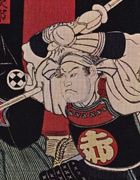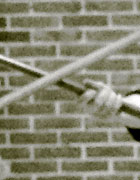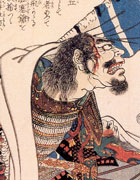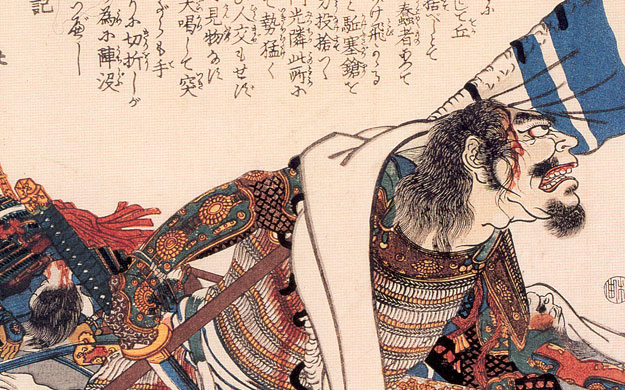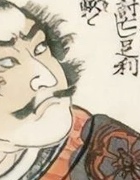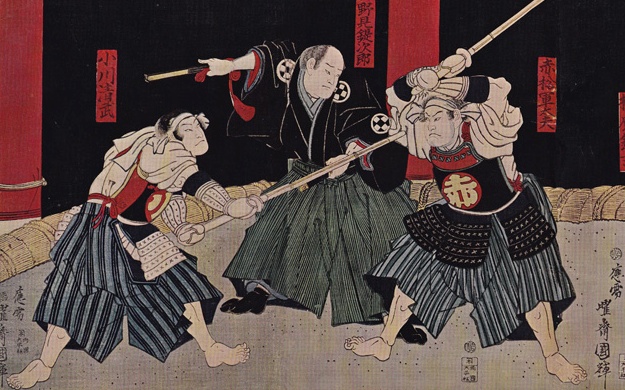
Katori Shinto Ryu is a non-antagonistic teaching system. With other words, the goal of practice is not to establish which of both partners is the best, but to give each partner tools for improvement. The kata are those tools and are comparable to the technical lessons of Western fencing masters of the past (and not to fencing bouts).
This expresses itself in the different roles that are performed in the kata: ukedachi and kirikomi.
‘Uke’ is derived from ‘ukemasu’. Here this means ‘to receive’ (the partner’s technique), identical to the taking of ‘ukemi’ in judo or aikido, though this is often wrongly translated as ‘to fall’.
‘Ukedachi’ is the person who receives. He is armed, therefore he is ukedachi (or uchitachi, ‘receiving sword’) genoemd; if he was unarmed he would be ‘ukete’ (‘receiving hand’). In all cases abbreviated as ‘uke’.
‘Kirikomi’ is the attacker, the ‘cutting side’ (kirimasu: ‘to cut’). In bojutsu, in which the attacker has a non-cutting weapon (stick), he is called ‘uchikomi’.
These roles change of course now and then in the course of a kata but at the end uke is always uke again and kirikomi performs the final attack. The fourth omote sword kata is a transition kata in which there is not much difference anymore between uke and kirikomi: kirikomi learns in this kata to be uke.
The right way to learn the omote sword kata is therefore: kirikomi 1st, 2nd, 3rd, 4th kata, ukedachi 1st, 2nd, 3rd, 4th kata. In everyday practice this does not happen often since there would be to few uke among the beginning students, who therefore cannot practice with each other.
The idea behind this system is to create a development from attacks with much power and speed but little subtlety to a more subtle way of fighting, sensitively reacting to one’s partner, being on the right moment in the right place rather than just trying to be fast, being capable to defend and to control and not only to attack.
This goal is of course not specific to Katori Shinto Ryu, but is to be found in all sword and fighting styles throughout ages and cultures. For example the roles of ukedachi and kirikomi are particularly evident in the following description of an 18th-century sword fight. The fight is in England and the goal is not to kill the opponent, but to amuse the audience and to compare skills; nevertheless the participants do not wear protective armour and have the intention to hit the opponent without themselves being hit. The superior sword fighter takes the uke role to control his rough-and-ready opponent.
Henry Angelo, in his Reminiscenses (1828), writes of his father, the famous sword master Domenico Angelo (1716-1802):
‘My father, who had never seen his antagonist until this moment, was rather surprised at the doctor’s appearance [his opponent Doctor Keyes], he being a tall, athletic figure, wearing a huge wig, without his coat and waistcoat, his shirt sleeves tucked up, exposing a pair of brawny arms, sufficient to cope in the ring with Broughton or Slack [famous boxing champions of their day]; and thus equipped, with foil in hand, he was pacing the apartment. The spectators being all assembled, after the first salutation from the doctor, which was sufficiently open and frank, previous to the assault he took a bumper of Cognac, and offered another to my father, which he politely refused, not being accustomed to so ardent a provocative [not used to strong liquor]. The doctor having thus spirited himself for the attack, began with that violence and determined method, which soon discovered to those who were skilled in the science, that, in the true sense of the term used by the French, he was no better than a tirailleur, jeu du soldat — Anglicised, a poker. My father, to indulge him in his mode of assault, for some time, solely defended against his repeated attacks without receiving one hit; for, as the brandy operated, a coup d’hasard [accidental hit] in the doctor’s favour would have only encouraged him the more. Hence, allowing his opponent to exhaust himself, and my father having sufficiently manifested his superior skill in the science, by thus acting on the defensive, with all the elegance and grace of attitude for which he was renowned, after having planted a dozen palpable hits on the breast of his enraged antagonist, he made his bow to the ladies, and retired amidst the plaudits of the spectators.’
